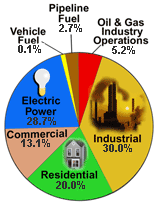|
Natural Gas Consumption
|
||||
|---|---|---|---|---|
|
Last Updated: May 2008
Next Update: February 2009 What is natural gas? Natural gas is a combustible gaseous mixture of hydrocarbons, mostly methane. Natural gas is mostly methane. It is best known as the fuel that produces the blue flame that heats our food, our water, and our homes and buildings. It is also used to generate electricity, provide heat for industrial processes, and as a raw material to produce petrochemicals, plastics, paints, and a wide variety of other products. For centuries, natural gas has been used in various parts of the world. Two-thousand years ago, the Chinese piped natural gas through bamboo poles from shallow wells. They then burned the gas to heat large pans to evaporate sea water for salt. It is believed that the first commercial use of natural gas in the Western World was for street lighting in Genoa, Italy, in 1802.
The top natural gas consuming States in 2006 were:
What is the forecast for natural gas use? Total U.S. natural gas consumption is projected to increase slightly from 21.66 Tcf in 2006 to 22.72 Tcf in 2030. The natural gas share of total energy consumption drops from 22.4 percent in 2006 to 19.8 percent in 2030. What is the world demand and outlook for natural gas? In 2006, world natural gas consumption was 105.5 Tcf. Russia, which consumed 16.6 Tcf, and the United States, which consumed 21.6 Tcf, accounted for 36 percent of the total. Worldwide consumption of natural gas is projected to increase by nearly 64 percent between 2004 and 2030. Among the end-use sectors, the industrial sector remains the largest consumer of natural gas worldwide, accounting for 42 percent of the total increase in demand for natural gas between 2004 and 2030. Natural gas also is expected to remain an important energy source in the electric power sector, particularly for new generating capacity. By the year 2030, total world consumption of natural gas is expected to be 163.2 Tcf.
More information on this subject can be found in the following EIA publications:
|
||||
